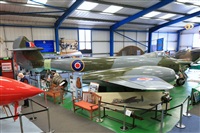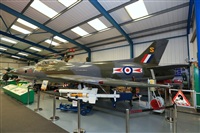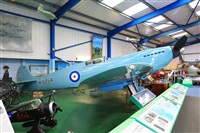|
|
|
|
|
|
|
|
|
|
|
|
|
|
Remarks |
|
Late morning on 30 August 1940, No 43 Squadron, based at RAF Tangmere, was airborne and engaging enemy aircraft over East Sussex. At 1150 hours, one of its Hurricanes, flown by twenty year old Sergeant Pilot Dennis Noble, was seen to dive away from the battle. Noble, sadly had been shot and killed in his aircraft and was therefore unable to pull out of the dive. His aircraft crashed vertically into the pavement of Woodhouse Road, Hove, near Brighton.
In August 1940, following his death, Dennis Noble was buried in Retford. However, when Keith Arnold, (the Museum’s Head of Maintenance) led an excavation of the crash site in November 1996 substantial remains of the pilot were found. A second funeral, with full military honours, took place in Retford on 22 January 1997.
SERGEANT PILOT DENNIS NOBLE’S HURRICANE, P3179, IS DISPLAYED IN THE MUSEUM’S BATTLE OF BRITAIN HALL AS A MEMORIAL TO THOSE OF THE ‘THE FEW’ WHO WERE KILLED DURING THE BATTLE OF BRITAIN.
|
|
|
|
|
|
|
|
|
|
|
|
|
|
|
|
|
|
|
|
|
|
Remarks |
|
|
The RAF High Speed Flight was reformed in late 1945 at Tangmere in order to make an attempt on the world air speed record. In August 1946, it received Meteor F4 EE549 direct from the Gloster Aircraft Company. On 7th September 1946, Gp Capt E M (Teddy) Donaldson set a new world record of 615.78 mph flying EE549 off the Sussex coast at Rustington. On returning from the Paris Air Show in January 1947, the same aircraft set a new record time of 20 min 11 sec between Paris (Le Bourget) and London (Croydon). She later saw service with the Fighter Command units before being retired to instructional airframe duties at Cranwell in June 1952.
|
|
|
|
|
|
|
|
|
|
|
|
|
|
|
|
|
|
|
|
|
|
Remarks |
|
|
ZA195 (cn 912034/DB.1) First flown on 9th September 1982. FRS.2 prototype from A&AEE Boscombe Down
|
|
|
|
|
|
|
|
|
|
|
|
|
|
|
|
|
|
|
|
|
|
Remarks |
|
|
The Westland Wessex was a turbine-powered version of the Sikorsky S-58, developed under licence for the Royal Navy and later the RAF. The aircraft was used initially in 1962 as a troop carrier (the HC2), and shortly thereafter as the HAR2 in the search and rescue role. Moreover, two machines were converted to HCC4 standard for VVIP duties with the Queen’s Flight. As a measure of its longevity in service, the Wessex was one of the RAF’s main transport helicopters from 1962 until the final unit, No 84 Squadron, retired its aircraft at RAF Akrotiri in January 2003 a total of some 40 years.
|
|
|
|
|
|
|
|
 |
|
1193
views |
|
|
|
|
 |
|
851
views |
|
|
|
|
 |
|
851
views |
|
|
|
|
|

